NEWS
Davidson’s Premier “Car Guy” Travels Dusty Trails Pursuing “Barn Finds”
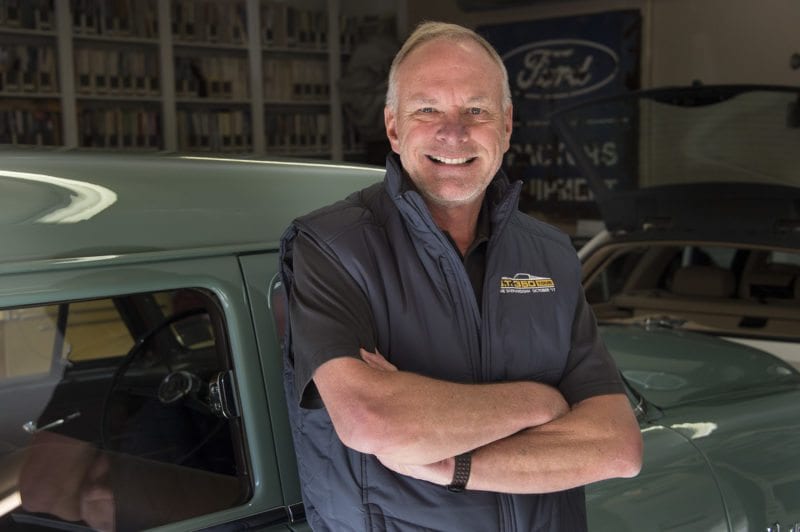
It’s a short walk for Cotter to work on his cars—just across the driveway from his house. (Bill Giduz photo)
Tom Cotter is one of our recent Distinguished Davidsonians. With a new book soon to be published, the 17th he has written, and with hundreds of thousands of viewers of his You Tube presentations, he has attained fame outside the confines of Davidson among car enthusiasts.
He describes himself as a “catch and release” sort of car guy. The thrill of the hunt and recording the find keeps him trolling old barns and byways across the United States in pursuit of mostly rusty, dusty old automobiles. When he finds an interesting specimen, he learns its provenance from the owner, turns the car over to his photographer, and heads on to seek another “barn find.”
He’s not out to buy cars, and only owns a few in his personal collection. Instead, he compiles his adventures and discoveries in books from Motorbooks Press. He’s already written 16 of them, including the whimsically titled “50 Shades of Rust: Barn Finds You Wish You’d Discovered,” and “The Corvette in the Barn: More Great Stories of Automotive Archaeology.”
This Davidson resident has crisscrossed the country many times in his quest for rare and interesting autos. His next book records a recent transcontinental adventure—“Ford Model-T Coast to Coast: A Slow Drive Across a Fast Country.” It’s the tale of driving a Model T along the whole Lincoln Highway, from Time Square to its terminus in San Francisco. The book will be published in April with a blurb from his buddy, Jay Leno, splashed across the back cover.
The Amazon review of Cotter’s books describe them as containing “Every car-guy’s fantasy—to casually peer into a long-forgotten garage or barn or warehouse and find the car he has searched for his whole life.… These are the stories that fuel the dreams of car collectors everywhere.”
GARAGE GETS PRIORITY OVER HOUSE
Born and raised on Long Island, Cotter purchased his first barn find at age 15, and has owned all manner of them ever since. When he and wife, Pat, moved to Davidson in 1998, they built a 40×60-foot detached garage before starting on the house. Tom and his son, Brian, spend countless hours in the garage restoring old cars. They are currently working on restoring a Lotus Elan, and rebuilding the motor in the son’s Porche 911. A 1952 MG-TD, a 2004 Mini Cooper S, and a 289 Cobra also get some love in that space. “I’ve restored or worked on hundreds of cars,” Cotter said. “It’s a zen-type activity. I just zone out and forget about everything else.”
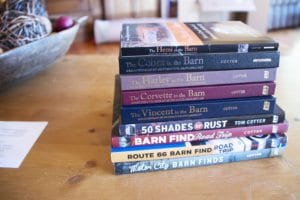
Cotter has published more than 15 hardcover books and hosted more than 25 YouTube shows about cars. (Bill Giduz photo)
While his publications record is prodigious, Tom said the nature of Davidson as a college community reserves public acclaim for new academic tomes, novels, and children’s books, rather than to his automotive books.
That’s changing, though, with the ascendancy of YouTube, which now carries “Barn Find Hunter” as an on-line program, extending his popularity from print to cyberspace.
BIG DAY FOR BARN FINDS IN LEADVILLE
Each of the 26 20-minute YouTube episodes (search “Tom Cotter” in YouTube) created thus far features Cotter as the narrator/host discovering old cars and talking about them with their owners. A short caption describes each episode. A typical one reads, “Tom drives his trusty 1939 Ford Woodie into the Rocky Mountains, with a stop in Leadville, Colo., where he discovers two dusty Porsches and a long-neglected Karmann Ghia. Later, while descending the mountains ahead of a wicked snowstorm, Tom spots a collection of classics off the highway.”
That episode concludes with him looking over cars in Leadville. He notes “Prospectors were looking for gold right here 100 years ago, and we are looking, as well. Only our gold is rust covered!” The series has proven so popular that episodes routinely garner 500,000 views, and one has topped two-million! Fellow car guys rave about the show in the comments space of the site, and request longer and more frequent segments. Its publisher, Hagerty, has heard the requests, and plans to increase production to twice a month, beginning in January.
LOOKING NOT FOR CARS, BUT CAR STORIES
The show succeeds because of Cotter’s affable, enthusiastic demeanor, intimate knowledge of his subjects, and ability to coax tales from the car owners. “I seek to discover the human-interest story with each car I find,” he said.
He analyzes the mechanical state of cars he finds, and explains their context in automotive history. He sometimes discusses the value of cars to demonstrate the tremendous bargains that many represent. But unlike shows such as “American Pickers,” he doesn’t haggle and purchase his finds. The show also benefits tremendously from skilled, professional videography by the technical crew who travel with him.
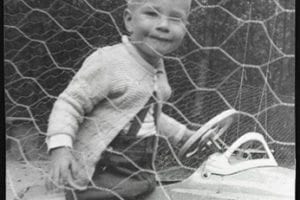
Hooked on cars from an early, early age. Cotter had his hands on the wheel almost before he could walk.
Cotter was born and raised on Long Island, and has been passionate about discovering cars since age 12. When he was 14, he spent $25 to buy a 1940 Ford convertible “like the one Lumpy drove on ‘Leave It To Beaver.’” He restored that one, then bought a 1939
Woodie Wagon that he still owns. It serves as his primary ride in the YouTube series, and he has driven it to California three times.
THE WOODIE MAKES IT GO
Tom contends that the Woodie makes the show go. He said, “Car owners wouldn’t give me the time of day if I didn’t have that car. The Woodie is the icebreaker. Driving up in a car like that, the owner wants to talk to me as much as I want to talk with him. Before you know it, we’re in his kitchen drinking lemonade and having a great day. It’s all about the people. Hardware is not fun to write about, but people are a lot of fun to write about.”
He continued, “Everybody has a car story. Just mention the words ‘Volkswagen Beetle’ and everyone has a Beetle story, or a Mustang story. It’s easy to get that topic going around the dinner table or in a bar. I don’t have to imagine writing about what an enthusiast wants, because I’m that enthusiast. If I find it interesting enough to write about, I know there’s a waiting audience of people who want to find out about it, too.”
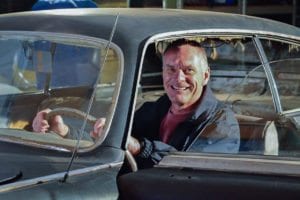
Cotter seated in his 1952 Cunningham C-3, one of just 25 in the world!
People frequently, ask Cotter how he finds cars. “They think you have to search all over the country, but you don’t,” he said. “They’re all over, just waiting to be discovered.” He starts many a day with no particular place to go, and simply follows his nose to auto parts stores, repair shops and garages, meeting someone along the way who gives him a lead to another find. Before long, he’s in Ojai, California, visiting with a collector who has 75 interesting cars scattered among the bush and in garages of his yard.
DIAMONDS IN THE ROUGH EVEN NEARBY
Nor does Cotter have to venture as far as California to find cars. He recalls opening an old garage that hadn’t seen the light of day since 1991. He was stunned by the cars inside— a 427 Cobra, a very rare 275 GTB Ferrari, a green Morgan, and a TR 6 Triumph with only 9,000 miles on it. He valued the Ferrari at $3.5 million, and the Cobra at $1.5 million.
Tom had found this treasure trove not in a far-away place, but in the Myers Park neighborhood in Charlotte! He explained, “Those cars were owned by a gentleman who ‘had some issues.’ So, he put them in the garage and closed the door. That shows that you don’t have to go across the country to find these things. Sometimes, you just have to go across town.”
The primary reason cars end up in barns is that people want to restore them, but just never get around it. Cotter said, “I ran into an 85-year-old man in that situation. I pointed out to him that if he hadn’t gotten around to restoring his car in the past 50 years, I wasn’t sure it was going to happen between now and his last day!”
Cotter worked in New York City for a while when living on Long Island, but found it hard to be a car guy there. He knew he had to find a way to get into the car business, and did that via becoming a writer. He gave away his stories for free to car publications like “Road and Track,” and little by little, his writing improved, and they began paying him for his work. That led to a career in public relations when a small firm in northern New Jersey hired him to handle its NASCAR account.
He did that for two years, and then in 1985 became publications director at Charlotte Motor Speedway. In 1989 he launched his own agency, Cotter Communications. Its first two employees were Tom and an assistant, but grew in 15 years to 90 people with a client list that included NASCAR, Mercedes-Benz, Ford, Dodge, Pontiac, BMW, and SPEED channel. His firm eventually was bought out, giving Cotter the resources to begin traveling the country and writing books about cars. He and Pat lived in Sherrill’s Ford for 13 years, then moved to Davidson in 1997.
He published his first book, which concerns the Holman-Moody racing enterprise, in 2000. In addition to the barn find series, he has also published books on Cuba’s Car Culture, vintage motorcycles, Detroit’s lost collector cars, and hot rod racer, Dean Jeffries.
LEADING THE COBRAS ACROSS MONTANA
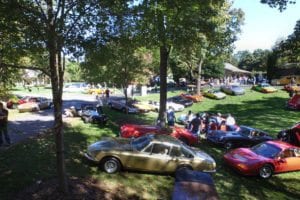
Several hundred fans bring their cars to display at Cotter’s annual car show in Davidson.
His increasing recognition in the car guy world has also opened up other opportunities. One of his hobbies involves leading tours for Cobras every year. Anywhere from 15-30 owners will get together in rural states like Montana “to drive great roads and stay in great places and have a great time.”
He has also begun a tradition of hosting an annual benefit car show at his home. It began with about 50 enthusiasts gathering to display their cars and enjoy barbecue and beer. Cotter turned the gathering into a charity event by asking attendees to bring a case of food, which he donated to the Ada Jenkins Community Center food bank. By last year the crowd increased to 300 people, and Cotter was asking for light-weight gift cards instead of heavy cases of canned food. He collected $8,000 that way for the center.
TIMES ARE CHANGING
Cotter observed reluctantly that times are changing for car guys like him. From one side, the membership of car clubs is diminishing, and youngsters are not filling the ranks. Secondly, cars are becoming more and more like appliances.
“We’re very close to driverless cars,” Cotter said. “Here we are at a junction in time very much like when horses and buggies were threatened by horseless carriages. Guys like Henry Ford had begun building these contraptions that smoked and banged and made terrible noises. Farmers protested and said “’We’re never going to give in to these things.’ Well, how many people are driving horse and buggies down Davidson Concord Road?”
He continued, “But of course we did give in to horseless carriages, and this is the next revolution. These horseless carriages will drive
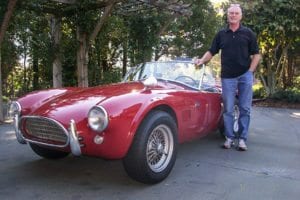
Cotter’s rare and powerful 289 Cobra.
themselves and we’ll just be occupants and not real drivers. We can be on our hand devices watching videos, or take a nap on the way to work.
Cotter concluded that “I’m one of those lucky people who was around at the right time to be able to turn my car hobby into a career. Cars have been the constant passion in my life. I was a mechanic, I had a repair shop when I got out of school, I’ve worked in an auto parts store, I’ve sold cars at a Ford dealership, and I was a PR and marketing guy and built a big agency. I’ll do anything it takes to be involved with cars. They’ve been the catalyst for a great life!”
Bill Giduz
Bill Giduz was the son who followed his father’s footsteps into journalism. He has been involved his entire life with news and photography in schools he attended and jobs he’s held. He believes now that he’s got a few good years left to devote to The News of Davidson.


